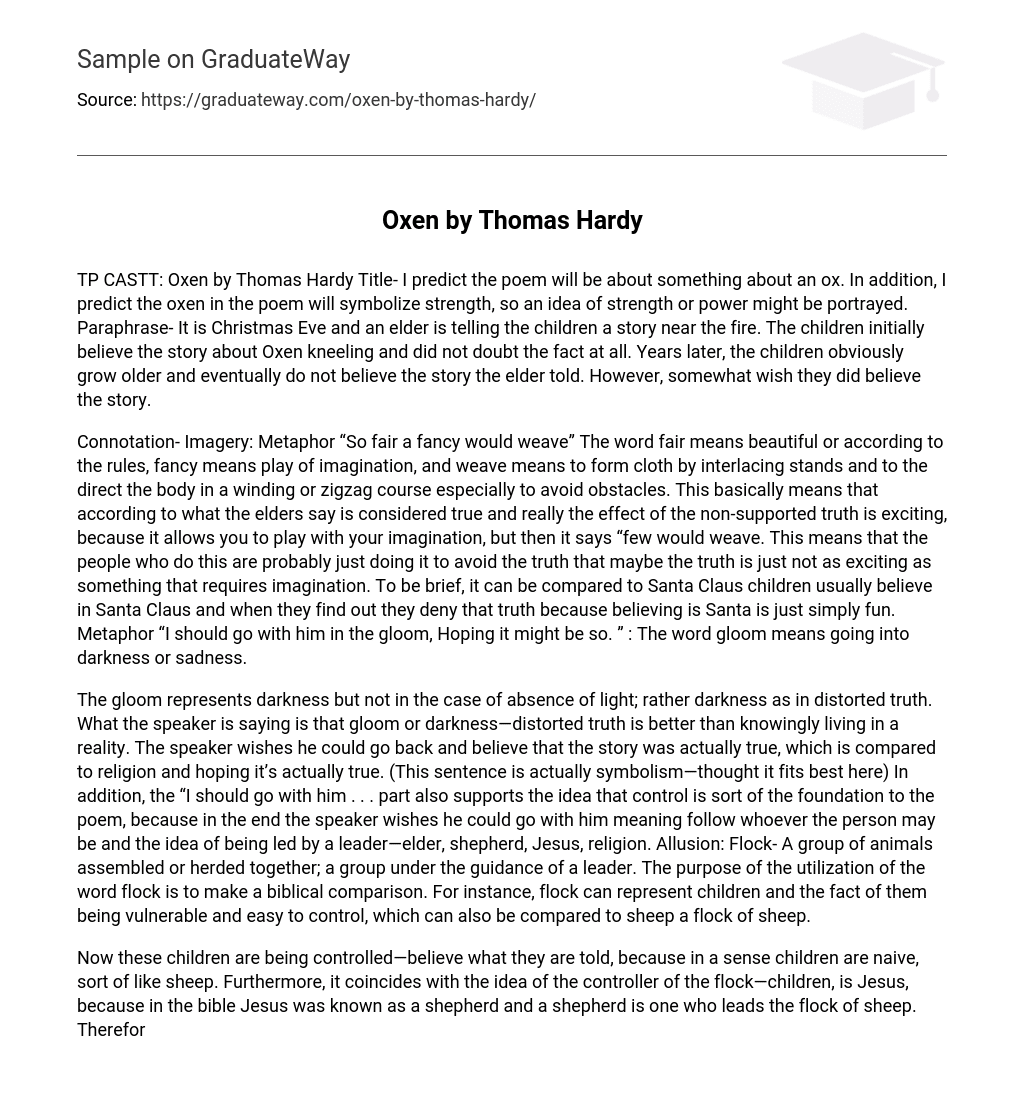I anticipate that the poem will center around an ox and its symbolic representation of strength. It is Christmas Eve, and an elder is sharing a story with the children alongside a cozy fire. Initially, the children fully embrace the tale of Oxen kneeling without any skepticism. As time passes and the children mature, they no longer hold faith in the elder’s story. Nevertheless, there is a lingering desire within them to believe in the narrative.
The connotation and imagery in the text can be understood through the metaphor used. The phrase “So fair a fancy would weave” implies that something that is beautiful or in accordance with the rules can ignite the imagination and creativity. It also suggests that this may not be a widely embraced idea, as indicated by the phrase “few would weave.” This means that only a small number of people engage in such imaginative thinking, possibly because they prefer avoiding the truth. This can be likened to children believing in Santa Claus, despite knowing deep down that it may not be true. It is simply more enjoyable to believe in something that requires imagination. Another metaphor used is “I should go with him in the gloom, Hoping it might be so.” Here, “gloom” signifies darkness or sadness.
The darkness symbolizes distorted truth rather than the absence of light. The speaker longs to believe in the story, comparing it to the hope of religion being true. The statement “I should go with him” relates to the theme of control in the poem, as the speaker wants to follow a leader, like an elder, shepherd, or Jesus. The use of the word “flock” alludes to a group under the guidance of a leader, drawing a biblical comparison. It signifies vulnerable children who are easily controlled, similar to a flock of sheep.
Now these children are being controlled—believe what they are told, because in a sense children are naive, sort of like sheep. Furthermore, it coincides with the idea of the controller of the flock—children, is Jesus, because in the bible Jesus was known as a shepherd and a shepherd is one who leads the flock of sheep. Therefore, the allusion made to the bible establishes a sort of a controlling feeling: these ideas ties in back with the oxen kneeling, which delineates obedience in one who is naive, childish, vulnerable to imagination, and needs to be lead. By the embers in hearthside ease”: The word ember means smoldering remains of fire. Diction: “Nor did it occur to one of us there To doubt they were kneeling”: The word “doubt” means to lack confidence in. “Doubt” is well utilized because it conveys the feelings and interpretation children have on the kneeling oxen. The children do not have any doubt or skepticism in their interpretation of the kneeling oxen and take in the story to be valid, which again supports the idea of children are easily convinced and believe what they are told, which all ties back with the controlling idea.
The significance of the word “there” is that it signifies the speaker’s use of past tense, indicating that the event referred to has already taken place. It is highly likely that the speaker is recounting this story many years later. The shift in attitude occurs as the poem takes place on Christmas Eve at midnight. The use of words like “we sat,” “pictured,” and “nor did it occur to one of us there” confirms that the poem is being told in past tense. An elder told the speaker a story that they, as children, believed. Then there is a shift indicated by the phrase “In these years” followed by an exclamation mark. This shift denotes the present moment. The speaker expresses a desire to go back and believe again, as indicated by the use of the word “yet.” The speaker’s overall attitude is one of reminiscence, regret, and optimism, as they long for the return to a time when they easily believed what they were told.
In the poem “Oxen,” Thomas Hardy explores the idea that religion can be perceived as a manipulative force that influences individuals to accept and embrace what they are told. Hardy also suggests that believing in something, regardless of its truthfulness, can bring more fulfillment and happiness compared to leading a negative and dull life of disbelief. Furthermore, the poem highlights the contrast between the naive nature of youth, who tend to unquestioningly accept what they are told, and the wisdom associated with old age.





